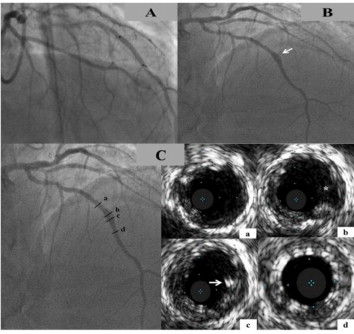Coronary artery aneurysm is a rare complication tha tmay be occurred after bare and drug-eluting stent implantation. Although some etiologic factors such as inflammation, hypersensitivity, drugtoxicity, vessel wall injury etc. have been proposed, its mechanism remains unclear. Bioresorbable stents opened a new era in interventional cardiology. The everolimus eluting Bioresorbable Vascular Scaffold (BVS) (AbbottVascular) is being tested currently in many studies with regard to its efficacy and safety. However, there are still many questions be answered. The risk of coronary aneurysm and late strut malapposition is theoretically possible after the BVS implantation. Herein, we presented a case of developing coronary aneurysm after one year from the BVS implantation.
Case
59 years-old male patient. His risk factors were diabetes, hypertension and smoking. He had been undergone coronary angiography after a stress test. There had been no significant disease in the right and circumflex coronary arteries. It had showed an intermediate stenosis in the midportion and a 70-80 % of tubularstenosis in the mid-distal portion of the left anterior decending artery (LAD). After coronary hemodynamic study with a pressure wire, a 2.5 x28 mm BVS has been implanted at the tubular stenosis in the mid-distalportion of the LAD following well predilation with a 2.5×20 NC baloon. A satisfactory result has been achieved after postdilation (Figure 1A). In his last control after one year, he suffered from stable angina for one month. The patient underwent control coronary angiography. We identified the formation of a small aneurysm in the middle part of the BVS (Figure 1B). Othe rfindings were almost the same with those of previous angiography. We performed the IVUS examination. In the distal part, the struts and the growing tissue between struts were clearly identifiable (Figure 2d). In the middle and proximal parts, some struts within the tissue could be seen (Figure 2a). It showed the development of aneurysm with relatively thinner vessel wall between 12 and 5 o’clock in the midpart of the BVS. In this region, we detected only one strut malapposition (Figure 2b and 2c). The patient has been followed medically.
Inconclusion , coronary aneurysm may develop after the BVS implantation. To our best knowledge, our case was one of very few patients presented in the current literatüre.





